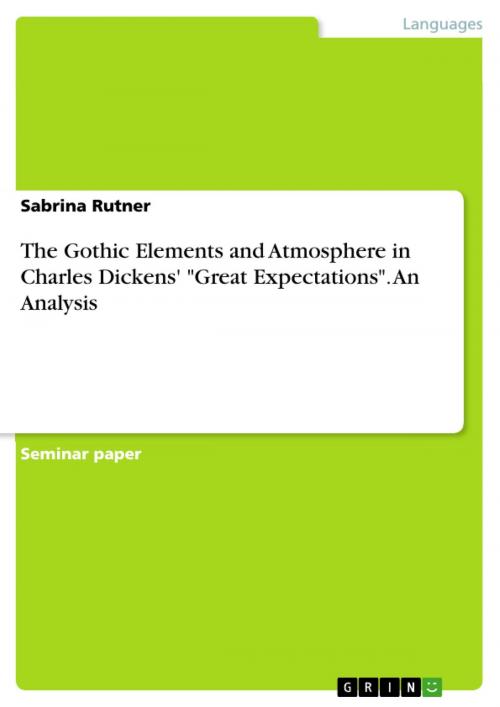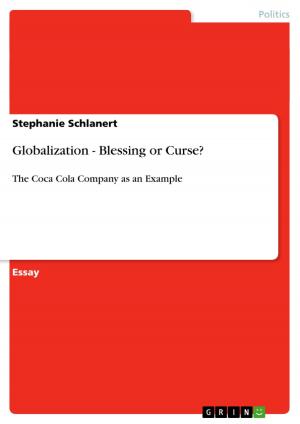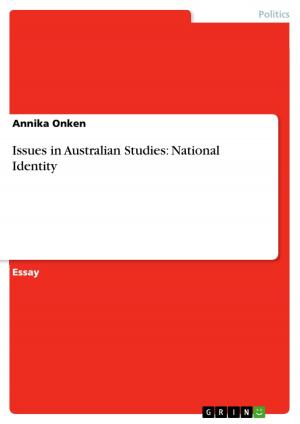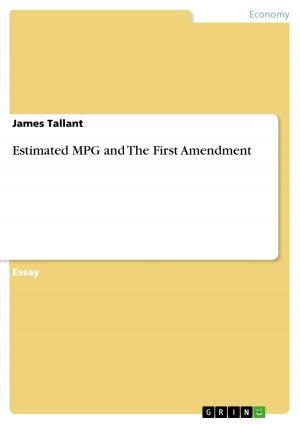The Gothic Elements and Atmosphere in Charles Dickens' 'Great Expectations'. An Analysis
Fiction & Literature, Literary Theory & Criticism, British| Author: | Sabrina Rutner | ISBN: | 9783668072497 |
| Publisher: | GRIN Publishing | Publication: | October 22, 2015 |
| Imprint: | GRIN Publishing | Language: | English |
| Author: | Sabrina Rutner |
| ISBN: | 9783668072497 |
| Publisher: | GRIN Publishing |
| Publication: | October 22, 2015 |
| Imprint: | GRIN Publishing |
| Language: | English |
Seminar paper from the year 2014 in the subject English - Literature, Works, grade: 1,7, University of Frankfurt (Main), language: English, abstract: This paper seeks to analyze the two most dominating Gothic elements in Charles Dickens' novel 'Great Expectations' and their effect on the atmosphere and on the development of the main protagonist Pip. From his earliest works, Dickens has included elements of Gothic literary conventions into his novels. Dickens used the rich atmospheric, thematic and metaphorical repertoire of Gothic elements to entertain his readers and to utter social critique. In his novels Dickens produces a scary, menacing and mysterious atmosphere and similarly depicts the social problems of the 'haunted British society' (Mighall 86). This is explicitly true for Dickens's novel 'Great Expectations'. In academic literature there have been diverse critical interpretations about Dickens's use of Gothic elements and their effect. However, it is still a growing field of academical research and only few Gothic elements of the novel Great Expectations are documented in detail. To get an overview of the Gothic novel's genre, the characteristic elements of Gothic novels will be introduced in brief. These are the Gothic setting as well as supernatural and irrational elements. To get an instrument for the analysis of the Gothic setting in 'Great Expectations', the characteristics of the Gothic novel's setting will be introduced. Then, the atmospheric effects of the settings Satis House, London, and the misty marshes in Dickens' 'Great Expectations' will be analyzed in detail. Also, their influence on Pip's personal development will be examined. Furthermore, the repertoire of the supernatural and irrational elements in the Gothic novel will be presented. In 'Great Expectations' these Gothic elements are represented through Pip's dreams and hallucinations which also add to the haunting atmosphere and illustrate Pip's development. In the end, the most important findings of the paper will be summarized and further aspects of the topic will be pointed out. Throughout the paper, it will be shown that the Gothic elements in 'Great Expectations' create a menacing and mysterious atmosphere and also illustrate and influence the personal development of Pip.
Seminar paper from the year 2014 in the subject English - Literature, Works, grade: 1,7, University of Frankfurt (Main), language: English, abstract: This paper seeks to analyze the two most dominating Gothic elements in Charles Dickens' novel 'Great Expectations' and their effect on the atmosphere and on the development of the main protagonist Pip. From his earliest works, Dickens has included elements of Gothic literary conventions into his novels. Dickens used the rich atmospheric, thematic and metaphorical repertoire of Gothic elements to entertain his readers and to utter social critique. In his novels Dickens produces a scary, menacing and mysterious atmosphere and similarly depicts the social problems of the 'haunted British society' (Mighall 86). This is explicitly true for Dickens's novel 'Great Expectations'. In academic literature there have been diverse critical interpretations about Dickens's use of Gothic elements and their effect. However, it is still a growing field of academical research and only few Gothic elements of the novel Great Expectations are documented in detail. To get an overview of the Gothic novel's genre, the characteristic elements of Gothic novels will be introduced in brief. These are the Gothic setting as well as supernatural and irrational elements. To get an instrument for the analysis of the Gothic setting in 'Great Expectations', the characteristics of the Gothic novel's setting will be introduced. Then, the atmospheric effects of the settings Satis House, London, and the misty marshes in Dickens' 'Great Expectations' will be analyzed in detail. Also, their influence on Pip's personal development will be examined. Furthermore, the repertoire of the supernatural and irrational elements in the Gothic novel will be presented. In 'Great Expectations' these Gothic elements are represented through Pip's dreams and hallucinations which also add to the haunting atmosphere and illustrate Pip's development. In the end, the most important findings of the paper will be summarized and further aspects of the topic will be pointed out. Throughout the paper, it will be shown that the Gothic elements in 'Great Expectations' create a menacing and mysterious atmosphere and also illustrate and influence the personal development of Pip.















